| Listing 1 - 10 of 33 | << page >> |
Sort by
|
Book
ISBN: 2880742714 9782880742713 Year: 1994 Publisher: Lausanne Presses polytechniques et universitaires romandes
Abstract | Keywords | Export | Availability | Bookmark
 Loading...
Loading...Choose an application
- Reference Manager
- EndNote
- RefWorks (Direct export to RefWorks)
Fuzzy systems --- Automation --- Systèmes flous --- Automatisation --- 62-52 --- Automatically operated or controlled machines and processes --- 62-52 Automatically operated or controlled machines and processes --- Systèmes flous --- COMPUTERS --- FUZZY LOGIC --- Monograph --- Computers. --- Fuzzy logic. --- Nonlinear logic --- Fuzzy mathematics --- Logic, Symbolic and mathematical --- Automatic computers --- Automatic data processors --- Computer hardware --- Computing machines (Computers) --- Electronic brains --- Electronic calculating-machines --- Electronic computers --- Hardware, Computer --- Computer systems --- Cybernetics --- Machine theory --- Calculators --- Cyberspace
Book
ISBN: 0131653814 Year: 1979 Publisher: Englewood Cliffs (N.J.): Prentice Hall international
Abstract | Keywords | Export | Availability | Bookmark
 Loading...
Loading...Choose an application
- Reference Manager
- EndNote
- RefWorks (Direct export to RefWorks)
Computers. --- Electronic data processing. --- Ordinateurs --- Informatique --- Computers --- Electronic data processing --- 681.3*A --- ADP (Data processing) --- Automatic data processing --- Data processing --- EDP (Data processing) --- IDP (Data processing) --- Integrated data processing --- Office practice --- Automatic computers --- Automatic data processors --- Computer hardware --- Computing machines (Computers) --- Electronic brains --- Electronic calculating-machines --- Electronic computers --- Hardware, Computer --- Computer systems --- Cybernetics --- Machine theory --- Calculators --- Cyberspace --- General literature --- Automation --- 681.3*A General literature
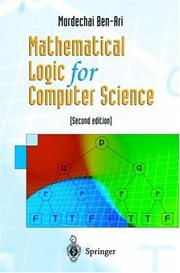
ISBN: 1852333197 1447103351 9781852333195 Year: 2003 Publisher: London Springer
Abstract | Keywords | Export | Availability | Bookmark
 Loading...
Loading...Choose an application
- Reference Manager
- EndNote
- RefWorks (Direct export to RefWorks)
Mathematical Logic for Computer Science is a mathematics textbook with theorems and proofs, but the choice of topics has been guided by the needs of computer science students. The method of semantic tableaux provides an elegant way to teach logic that is both theoretically sound and yet sufficiently elementary for undergraduates. To provide a balanced treatment of logic, tableaux are related to deductive proof systems. The logical systems presented are: - Propositional calculus (including binary decision diagrams); - Predicate calculus; - Resolution; - Hoare logic; - Z; - Temporal logic. Answers to exercises (for instructors only) as well as Prolog source code for algorithms may be found via the Springer London web site: http://www.springer.com/978-1-85233-319-5 Mordechai Ben-Ari is an associate professor in the Department of Science Teaching of the Weizmann Institute of Science. He is the author of numerous textbooks on concurrency, programming languages and logic, and has developed software tools for teaching concurrency. In 2004, Ben-Ari received the ACM/SIGCSE Award for Outstanding Contributions to Computer Science Education.
Logic, Symbolic and mathematical --- Logic, Symbolic and mathematical. --- Mathematical logic --- Computer. Automation --- Computers. --- Mathematical logic. --- Theory of Computation. --- Mathematical Logic and Foundations. --- Mathematical Logic and Formal Languages. --- Algebra of logic --- Logic, Universal --- Symbolic and mathematical logic --- Symbolic logic --- Mathematics --- Algebra, Abstract --- Metamathematics --- Set theory --- Syllogism --- Automatic computers --- Automatic data processors --- Computer hardware --- Computing machines (Computers) --- Electronic brains --- Electronic calculating-machines --- Electronic computers --- Hardware, Computer --- Computer systems --- Cybernetics --- Machine theory --- Calculators --- Cyberspace
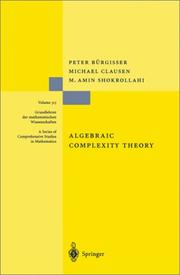
ISSN: 00727830 ISBN: 3540605827 3642082289 3662033380 9783540605829 Year: 1997 Volume: 315 Publisher: Berlin: Springer,
Abstract | Keywords | Export | Availability | Bookmark
 Loading...
Loading...Choose an application
- Reference Manager
- EndNote
- RefWorks (Direct export to RefWorks)
The algorithmic solution of problems has always been one of the major concerns of mathematics. For a long time such solutions were based on an intuitive notion of algorithm. It is only in this century that metamathematical problems have led to the intensive search for a precise and sufficiently general formalization of the notions of computability and algorithm. In the 1930s, a number of quite different concepts for this purpose were pro posed, such as Turing machines, WHILE-programs, recursive functions, Markov algorithms, and Thue systems. All these concepts turned out to be equivalent, a fact summarized in Church's thesis, which says that the resulting definitions form an adequate formalization of the intuitive notion of computability. This had and continues to have an enormous effect. First of all, with these notions it has been possible to prove that various problems are algorithmically unsolvable. Among of group these undecidable problems are the halting problem, the word problem theory, the Post correspondence problem, and Hilbert's tenth problem. Secondly, concepts like Turing machines and WHILE-programs had a strong influence on the development of the first computers and programming languages. In the era of digital computers, the question of finding efficient solutions to algorithmically solvable problems has become increasingly important. In addition, the fact that some problems can be solved very efficiently, while others seem to defy all attempts to find an efficient solution, has called for a deeper under standing of the intrinsic computational difficulty of problems.
Numerical solutions of algebraic equations --- Computer science --- Computational Complexity --- Computational complexity --- Computational complexity. --- Complexité de calcul (Informatique) --- Combinatorics. --- Computers. --- Mathematical logic. --- Algorithms. --- Algebraic geometry. --- Theory of Computation. --- Mathematical Logic and Foundations. --- Algorithm Analysis and Problem Complexity. --- Algebraic Geometry. --- Algebraic geometry --- Geometry --- Algorism --- Algebra --- Arithmetic --- Algebra of logic --- Logic, Universal --- Mathematical logic --- Symbolic and mathematical logic --- Symbolic logic --- Mathematics --- Algebra, Abstract --- Metamathematics --- Set theory --- Syllogism --- Automatic computers --- Automatic data processors --- Computer hardware --- Computing machines (Computers) --- Electronic brains --- Electronic calculating-machines --- Electronic computers --- Hardware, Computer --- Computer systems --- Cybernetics --- Machine theory --- Calculators --- Cyberspace --- Combinatorics --- Mathematical analysis --- Foundations

ISBN: 0444884106 Year: 1997 Publisher: Amsterdam [etc.] : Elsevier,
Abstract | Keywords | Export | Availability | Bookmark
 Loading...
Loading...Choose an application
- Reference Manager
- EndNote
- RefWorks (Direct export to RefWorks)
French language --- Computer. Automation --- English language --- German language --- Computers --- -English language --- -Information technology --- -(038)004 --- Engels-Duits --- Engels-Frans --- informatica --- informatietechnologie --- vakwoordenboeken --- verklarende woordenboeken --- vertalende woordenboeken --- woordenboeken --- Germanic languages --- IT (Information technology) --- Technology --- Telematics --- Information superhighway --- Knowledge management --- Automatic computers --- Automatic data processors --- Computer hardware --- Computing machines (Computers) --- Electronic brains --- Electronic calculating-machines --- Electronic computers --- Hardware, Computer --- Computer systems --- Cybernetics --- Machine theory --- Calculators --- Cyberspace --- Dictionaries --- -French --- -German --- Woordenboeken computerkunde en computertechnologie --- Informatietechnologie --- Nieuwe media --- woordenboeken. --- Woordenboeken. --- Information technology --- (038)004 --- French --- Dictionaries&delete& --- German
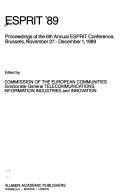
ISBN: 0792305922 9401069689 9400910630 9780792305927 Year: 1989 Volume: 12512 Publisher: Dordrecht Kluwer
Abstract | Keywords | Export | Availability | Bookmark
 Loading...
Loading...Choose an application
- Reference Manager
- EndNote
- RefWorks (Direct export to RefWorks)
Computer. Automation --- Cybernetics --- Communication --- Computers --- Information technology --- Ordinateurs --- Technologie de l'information --- Congresses --- Congrès --- Conferences - Meetings --- -Cybernetics --- -Communication --- -Computers --- -#TELE:d.d. Prof. A. J. J. Oosterlinck --- 681.3 --- 681.3*A --- Automatic computers --- Automatic data processors --- Computer hardware --- Computing machines (Computers) --- Electronic brains --- Electronic calculating-machines --- Electronic computers --- Hardware, Computer --- Computer systems --- Machine theory --- Calculators --- Cyberspace --- Communication, Primitive --- Mass communication --- Sociology --- Mechanical brains --- Control theory --- Electronics --- System theory --- IT (Information technology) --- Technology --- Telematics --- Information superhighway --- Knowledge management --- Computerwetenschap --- General literature --- Congresses. --- 681.3*A General literature --- #TELE:d.d. Prof. A. J. J. Oosterlinck --- 681.3* / / / / / / / / / / / / / / / / / / / / / / / / / / / / --- Information technology - Congresses --- Cybernetics - Congresses --- Communication - Congresses --- Computers - Congresses
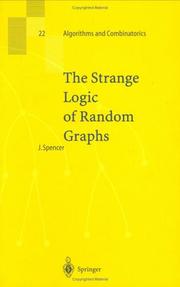
ISBN: 3540416544 3642074995 3662045389 9783540416548 Year: 2001 Volume: 22 Publisher: Berlin Springer
Abstract | Keywords | Export | Availability | Bookmark
 Loading...
Loading...Choose an application
- Reference Manager
- EndNote
- RefWorks (Direct export to RefWorks)
The study of random graphs was begun by Paul Erdos and Alfred Renyi in the 1960s and now has a comprehensive literature. A compelling element has been the threshold function, a short range in which events rapidly move from almost certainly false to almost certainly true. This book now joins the study of random graphs (and other random discrete objects) with mathematical logic. The possible threshold phenomena are studied for all statements expressible in a given language. Often there is a zero-one law, that every statement holds with probability near zero or near one. The methodologies involve probability, discrete structures and logic, with an emphasis on discrete structures. The book will be of interest to graduate students and researchers in discrete mathematics.
Discrete mathematics --- Random graphs --- Logic, Symbolic and mathematical --- Graphes aléatoires --- Logique symbolique et mathématique --- Logic, symbolic and mathematical --- Logic, Symbolic and mathematical. --- Random graphs. --- Graphes aléatoires --- Logique symbolique et mathématique --- Graphes, Théorie des. --- Graphes aléatoires. --- Graph theory --- Discrete mathematics. --- Combinatorics. --- Computers. --- Computer science—Mathematics. --- Discrete Mathematics. --- Theory of Computation. --- Mathematics of Computing. --- Automatic computers --- Automatic data processors --- Computer hardware --- Computing machines (Computers) --- Electronic brains --- Electronic calculating-machines --- Electronic computers --- Hardware, Computer --- Computer systems --- Cybernetics --- Machine theory --- Calculators --- Cyberspace --- Combinatorics --- Algebra --- Mathematical analysis --- Discrete mathematical structures --- Mathematical structures, Discrete --- Structures, Discrete mathematical --- Numerical analysis --- Graphes, Théorie des --- Graph theory. --- Logique mathematique --- Logique du premier ordre

ISBN: 3540626166 3540683429 9783540626169 Year: 1997 Volume: 1200 Publisher: Berlin ; Heidelberg ; New York Springer Verlag
Abstract | Keywords | Export | Availability | Bookmark
 Loading...
Loading...Choose an application
- Reference Manager
- EndNote
- RefWorks (Direct export to RefWorks)
This book constitutes the refereed proceedings of the 14th Annual Symposium on Theoretical Aspects of Computer Science, STACS 97, held in Lübeck, Germany, in February/March 1997. The 46 revised full papers included were carefully selected from a total of 139 submissions; also included are three invited full papers. The papers presented span the whole scope of theoretical computer science. Among the topics covered are, in particular, algorithms and data structures, computational complexity, automata and formal languages, structural complexity, parallel and distributed systems, parallel algorithms, semantics, specification and verification, logic, computational geometry, cryptography, learning and inductive inference.
Computer science --- Informatique --- Congresses. --- Congrès --- Computer Science --- Engineering & Applied Sciences --- Congresses --- Congrès --- Computer science. --- Computer programming. --- Programming languages (Electronic computers). --- Computers. --- Computer Science. --- Theory of Computation. --- Programming Techniques. --- Programming Languages, Compilers, Interpreters. --- Discrete Mathematics in Computer Science. --- Mathematics. --- Information theory. --- Computational complexity. --- Complexity, Computational --- Electronic data processing --- Machine theory --- Communication theory --- Communication --- Cybernetics --- Informatics --- Science --- Computer science—Mathematics. --- Computer languages --- Computer program languages --- Computer programming languages --- Machine language --- Languages, Artificial --- Computers --- Electronic computer programming --- Electronic digital computers --- Programming (Electronic computers) --- Coding theory --- Automatic computers --- Automatic data processors --- Computer hardware --- Computing machines (Computers) --- Electronic brains --- Electronic calculating-machines --- Electronic computers --- Hardware, Computer --- Computer systems --- Calculators --- Cyberspace --- Programming --- Computer science - Congresses.
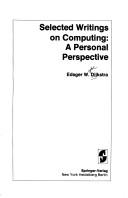
ISBN: 0387906525 3540906525 1461256976 146125695X 9780387906522 Year: 1982 Publisher: New York: Springer,
Abstract | Keywords | Export | Availability | Bookmark
 Loading...
Loading...Choose an application
- Reference Manager
- EndNote
- RefWorks (Direct export to RefWorks)
Electronic data processing --- Computers --- Computer programming --- Informatique --- Ordinateurs --- Programmation (Informatique) --- 681.3*A1 --- Electronic computer programming --- Electronic digital computers --- Programming (Electronic computers) --- Coding theory --- ADP (Data processing) --- Automatic data processing --- Data processing --- EDP (Data processing) --- IDP (Data processing) --- Integrated data processing --- Office practice --- Automatic computers --- Automatic data processors --- Computer hardware --- Computing machines (Computers) --- Electronic brains --- Electronic calculating-machines --- Electronic computers --- Hardware, Computer --- Computer systems --- Cybernetics --- Machine theory --- Calculators --- Cyberspace --- Introductory and survey --- Programming --- Automation --- Computer programming. --- Computers. --- Electronic data processing. --- 681.3*A1 Introductory and survey --- Computing

ISBN: 1590594916 9786610700448 1280700440 1430200375 Year: 2005 Publisher: Berkeley, CA : Apress : Imprint: Apress,
Abstract | Keywords | Export | Availability | Bookmark
 Loading...
Loading...Choose an application
- Reference Manager
- EndNote
- RefWorks (Direct export to RefWorks)
Are you completely new to programming? Do you want to have fun learning to program? Squeak: Learn Programming with Robots will teach you core programming concepts based on simple, visual problems that involve manipulation of robots, or "turtles." You will learn basic programming concepts like loops, abstractions, composition, and conditionals. Each chapter is structured so that it can be turned into a one- or two-hour lab session. And while the structured content explains solid principles of object-oriented programming, you'll just have fun going through the sequence of easy examples with the turtle. And be sure to check out BotsInc, the companion learning environment for this book.
Robots --- Programming --- Programmation --- Artificial intelligence. --- Robotics. --- Robots -- Programming. --- Computer Science --- Mechanical Engineering - General --- Engineering & Applied Sciences --- Mechanical Engineering --- Programming. --- EPUB-LIV-FT LIVINFOR SPRINGER-B --- Robot programming --- Computer science. --- Software engineering. --- Computer Science. --- Software Engineering/Programming and Operating Systems. --- Computer programming --- Computer input-output equipment. --- Hardware and Maker. --- Computer software engineering --- Engineering --- Computer hardware --- Computer I/O equipment --- Computers --- Electronic analog computers --- Electronic digital computers --- Hardware, Computer --- I/O equipment (Computers) --- Input equipment (Computers) --- Input-output equipment (Computers) --- Output equipment (Computers) --- Computer systems --- Input-output equipment
| Listing 1 - 10 of 33 | << page >> |
Sort by
|

 Search
Search Feedback
Feedback About
About Help
Help News
News